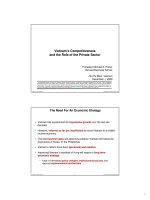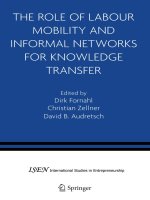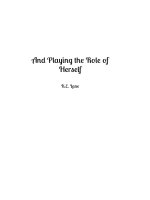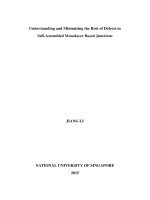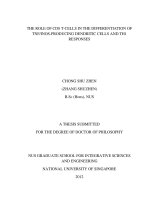The role of different medium and plant hormones on multiple shoots of Jewel orchids (Anoectochilus setaceus Blume)
Bạn đang xem bản rút gọn của tài liệu. Xem và tải ngay bản đầy đủ của tài liệu tại đây (1.48 MB, 7 trang )
<span class='text_page_counter'>(1)</span><div class='page_container' data-page=1>
47
The role of different medium and plant hormones on multiple
shoots of Jewel orchids (Anoectochilus setaceus Blume)
Nguyen Trung Thanh
1,*, Pham Luong Hang
1, Nguyen Van Ket
2,
Truong Thi Lan Anh
2, Phung Van Phe
3, Nguyen Thi Hong Gam
3, Phi Thi Cam Mien
41<i><sub>Faculty of Biology, VNU University of Science, 334 Nguyen Trai, Hanoi, Vietnam </sub></i>
2
<i>Faculty of Agriculture Forestry, Dalat University, 01 Phu Dong Thien Vuong, Da Lat, Vietnam </i>
3
<i>Faculty of Silviculture, Vietnam Forestry University, Xuan Mai, Chuong My, Hanoi, Vietnam </i>
4
<i>Faculty of Agronomy, Hanoi University of Agriculture, Trau Quy, Gia Lam, Hanoi, Vietnam </i>
<b>Received 24 December 2011 </b>
<i><b>Abstract. Use of Anoectochilus setaceus species have increased in the past few years due to the </b></i>
antidepressant and antiviral activities found in extracts of those plants. As a result of its potential
<i>as a pharmaceutical, a new system was developed for in vitro culture of this species. The goal of </i>
<i>this investigation was to produce multiple shoot via in vitro techniques for Anoectochilus setaceus. </i>
The basal MS and Knud medium were tested and shown to be equally suitable of them for shoot
<i>culture of A. setaceus. Othe cultures were initiated from shoots inoculated onto MS medium </i>
supplemented individually with six different concentrations of 6-Benzylaminopurine (BAP) and
Kinetin (Kn). The highest number of shoots was obtained on medium supplemented with 0.6 mg l
-1<sub> BAP (3.8 shoot/explant). Out of all the investigated concentrations of Kn, the best result was </sub>
obtained on medium supplemented with 1.0 mg l-1 Kn (3.2 shoot/explant).
<i>Keywords: Jewel orchids (Anoectochilus setaceus), plant hormones, the multiple shoot induction. </i>
<b>1. Introduction</b>∗∗∗∗
<i>Anoectochilus</i> is a genus of about 50
orchids (family Orchidaceae) belonging to the
subfamily <i>Orchidoideae</i> [1]. They are
sometimes called "Jewel orchids" because of
their attractive foliar venation. Found in
Yunnan China, Assam India, Bangladesh,
eatern Himalayas, Nepal, western Himalayas,
Sri Lanka, Myanamar, Thailand, Vietnam,
Sumatra and Java in broadleafed, evergreen,
_______
∗
Corresponding author. Tel: 84-4-38582178.
E-mail:
humid primary forests in soils dampened by
mists and splash along steep watercourses at
elevations of 800 to 1800 meters as a creeping,
ascending, warm to cool growing terrestrial
orchid in rich humus in damp crevasses with
subcordate to ovate-acute, velvety, dark
lime-green reticulated with gold leaves that are puple
black on the underside that blooms on a 10" (25
cm) long, several (5) flowered inflorescence
with successively opening flowers occuring in
the summer [2-3].
</div>
<span class='text_page_counter'>(2)</span><div class='page_container' data-page=2>
Almost every civilization has a history of
medicinal plant use [3]. Approximately 80% of
the people in the world’s developing countries
rely on traditional medicine for their primary
health care needs, and about 85% of traditional
medicine involves the use of plant extracts [4].
Interest in phytomedicine has exploded in the
last few years, and about 500 different plant
species are used as key ingredients, and many
are still being collected from the wild [5].
Plants can be regenerated and mass
propagated in vitro either by shoot
morphogenesis or somatic embryogenesis.
Many important Chinese traditional medicinal
herbs have been successfully regenerated in
vitro. Each has a particular group of bioactive
compounds. Taxol (plaxitaxol), a complex
<i>diterpene alkaloid found in the bark of Taxus </i>
tree is one of the most promising anticancer
agents due to its unique mode of action on
<i>microtubular cell system [6]. The root of Panax </i>
<i>ginseng </i>C.A.Mayer, has been widely used as a
tonic and preciousmedicine since ancient times
[7]. The primary bioactive constituents of
ginseng are ginsenosides, a group of
triterpenoid saponins [8]. Berberine is an
<i>isoquinoline alkaloid found in roots of Coptis </i>
<i>japonica</i> [9].
In this paper, we established in vitro culture
of <i>A. setaceus</i> and some attempts have been
made to increase the number of adventitious
<b>shoots in vitro culture. </b>
<b>2. Materials and Methods </b>
<i>Plant material </i>
<i>Jewel orchids (Anoectochilus setaceus) </i>
plants were collected at Tam Dao National
Park, Vinh Phuc province. The samples were
first soaked in 70% (v/v) ethanol for 30 seconds
and then treated with 10% (w/v) sodium
hypochlorite (NaOCl) for 15 min, followed by
3-4 rinses with sterile water for surface
sterilization. The sterilized samples were grown
on MS basal medium [10] without growth
regulators to produce plantlets. The subcultures
were carried in our laboratory as stock plants.
<i>Shoot elongation and rooting </i>
After culture for 8 weeks, the adventitious
shoots regenerated from explants were
transferred to hormone-free MS medium for
shoot elongation. When the shoots reached
0.5-1.5 cm in height, they were transferred onto
basal MS medium supplemented with 0.1-2.0
mg l-1 BAP (6-Benzylaminopurine) and Kn
(Kinetin or 6- Furfurylaminopurine) [11] for
<b>shooting and rooting. </b>
<i>Culture conditions and data analysis </i>
Uniform culture conditions were applied in
all experiments. All experiments were
conducted 3 replicates with 250 ml conical
flasks in each and 12-15 explants were cultured
in every 250 ml conical flask. The pH of the
media was adjusted to 5.7 before autoclaving.
The media was autoclaved for 15 min at 121°C.
Cultures were incubated at 25 ± 2°C under a 16
h photoperiod with cold white fluorescent light
mixed with incandescent light at 55.6 µmol m-2
s-1. All data were analyzed using standard
applied method.
<b>3. Results and discussion </b>
<i>3.1. Effect of basal media on growth of </i>
<i>Anoectochilus setaceus cultured in vitro </i>
</div>
<span class='text_page_counter'>(3)</span><div class='page_container' data-page=3>
<i>suitable of them for shoot tip culture of A. </i>
<i>setaceus </i>(Table 1). The culture of shoots in
these media showed good growth after 8 weeks
culture. Shoot length was about 3.5-5.0 cm with
<i>5 to 10 leaves per shoot. Shoot tips of A. </i>
<i>setaceus </i>cultured on MS or Knud without PGRs
developed 2-5 additional shoots within 8 weeks
of culture.
<i>Table 1. The effects of different basal media on multiple shoot induction of A. setaceus </i>
Medium Avg length of shoots (cm)
(Mean ± SE)
Number of
shoot/explant
Number of
leaves/planlet
MS 4.4 ± 0.9 3.5 ± 1.5 7.5 ± 2.5
Knud 4.6 ± 0.5 3.2 ± 1.7 6.3 ± 3.3
Basically, a nutrient medium consists of all
of the essential major and minor plant nutrient
elements, vitamins, plant growth regulators, and
a carbohydrate as carbon source with other
organic substances as optional additives [12].
The medium described by [10] (MS medium) is
<i>most commonly used. The growth response of </i>
<i>A. setaceus</i> also showed the best result on the
MS medium.
The mineral requirement of orchids is
generally not high, and salt poor medium is
usually recommended. Beside the MS medium,
the modified [13] also often used for
<i>micropropagation of orchids such as Cattleya, </i>
<i>and Cymbidium [14]. Knud medium frequently </i>
used for the growth of orchids performed very
poorly in this experiment when compared to
MS medium. Probably salt poor in Knud
<i>medium is also further suitable for growth of A. </i>
<i>setaceus</i>. For further experiments on shoot
growth and proliferation, we used MS media
because it is commonly, commercially and
available.
<i>3.2. The effects of different concentrations of </i>
<i>BAP on multiple shoot induction of Jewel orchids </i>
<i>(Anoectochilus setaceus Blume) cultured in vitro </i>
The application of molecular approaches
with medicinal plants would also benefit from
the development of cell, tissue and organ
<i>culture systems for in vitro growth and </i>
regeneration of medicinal plants. In addition,
such tissue culture systems could also prove
useful for large-scale biotechnological
production of medicinal plant phytochemicals
[15]. Furthermore, uniform plant growth with
consistent plant material can be achieved, plants
can be grown in sterile, standardized conditions
and are free from biotic and abiotic
contamination.
</div>
<span class='text_page_counter'>(4)</span><div class='page_container' data-page=4>
tested (Table 2). The highest and the lowest
number of shoots were obtained on the medium
supplemented with 0.6 mg l-1 (Fig. B) and 0.1
mg l-1 of BAP (3.8-1.7 shoot/explant,
respectively).
<i>Table 2. The effects of concentrations of BAP on multiple shoot induction of Anoectochilus setaceus </i>
Concentrations of
BAP (mg l-1)
Avg No of shoots/explant
(Mean ± SE)
Avg length of shoots (cm)
(Mean ± SE)
Control 1.0 ± 0.2 2.0 ± 0.3
0.1 1.7 ± 0.2 3.5 ± 0.3
0.3 2.9 ± 0.3 4.9 ± 0.5
0.6 3.8 ± 0.2 6.6 ± 0.4
1.0 3.4 ± 0.3 6.6 ± 0.4
1.5 3.0 ± 0.2 6.3 ± 0.3
2.0 2.8 ± 0.3 6.4 ± 0.2
<i>3.3. The effects of different concentrations of </i>
<i>Kinetin on multiple shoot induction of Jewel </i>
<i>orchids </i> <i>(Anoectochilus </i> <i>setaceus </i> <i>Blume) </i>
<i>cultured in vitro </i>
All the investigated concentrations of Kn
showed shoot production. However, the best
result was obtained on the medium
supplemented with 1.0 mg l-1 Kn (Fig. C). From
the results presented in Table 3, it appears that
the number of shoot rises by increasing the
concentration of Kn. However, smaller and
shorter shoots were formed as the concentration
of Kn increased in the culture medium.
Excessive shoot length and root formation were
observed on the medium containing low
concentrations of Kn (from 0.6 to 1.5 mg l-1)
(Fig. D).
<i>Table 3. The effects of concentrations of Kinetins on multiple shoot induction of Anoectochilus setaceus Blume </i>
Concentrations of Kn
(mg l-1)
Avg No of shoots/explant
(Mean ±SE)
Avg length of shoots (cm)
(Mean ±SE)
Control 1.2 ± 0.3 2.2 ± 0.3
0.1 1.7 ± 0.3 2.5 ± 0.4
0.3 2.1 ± 0.4 3.5 ± 0.5
0.6 2.5 ± 0.3 4.3 ± 0.4
1.0 3.2 ± 0.3 6.1 ± 0.4
1.5 3.2 ± 0.2 6.3 ± 0.3
2.0 3.3 ± 0.4 5.5 ± 0.1
The results indicated that the highest shoot
number formed on the medium supplemented
with 2.0 mg l-1 of Kn (3.3 shoots/explant).
</div>
<span class='text_page_counter'>(5)</span><div class='page_container' data-page=5>
vitrification in shoots. Therefore, a culture
medium with 1.0 mg l-1 of Kn was sufficient to
produce multiple shoot and an average of 3.2
shoots formed from each explant in this
medium within eight weeks (Table 3). In the
morphological observations, Kn concentrations
surpassed other media (BAP concentrations) in
terms of mean shoot length, leaf width and root
formation.
In comparison of all treatments of two
cytokinins with control group (Table 2-3), it
was determined that the medium should be
supplemented with exogenous hormones
(PGRs) for new shoot formation.
In conclusion, shoots were successfully
propagated after two subcultures in the presence
of BAP or Kn. Among the cytokinins (BAP, Kn
concentrations), BAP was reported to be more
efficient than Kn in promoting shoot formation.
Our findings are compatible with those of [16],
<i>who reported that in H. perforatum, BAP was </i>
found to be the most efficient in shoot
formation when excised parts of seedlings were
<i>used. Also, for H. perforatum L., BAP was </i>
found to be the most efficient in promoting
shoot regeneration when leaves [17] were used
as the explant.
Fig 1. In vitro propagation via shoot morphogenesis: Induction of multiple shoots from shoot tips with
supplemented BAP and Kin showed as A-B and C-D, respectively.
AB
C
A
</div>
<span class='text_page_counter'>(6)</span><div class='page_container' data-page=6>
<b>Acknowledgment </b>
This work was supported by grants from
Vietnam National University, Hanoi, Code:
QGTD.11.02 as the sponsor of the research
project. We also wish to thank the Manage
Board of Tam Dao National Park, Department
of Forest Vinh Phuc province for help during
our sample collecting.
<b>References </b>
[1] Ban N.T. (Editor), the list of plant in Vietnam,
Vol. 3, pp. 512-666, Publisher of Agriculture,
Hanoi, 2005, (In Vietnamese).
[2] Constable, F. Medicinal plant biotechnology,
<i>Planta Med.</i> 56 (1990) 421-425.
[3] Ensminger A.H., M E. Ensminger, J E.
<i>Konlande, and J.R.K. Robson, Food & </i>
<i>Nutrition Encyclopedia</i>, Vol. 2, pp. 1427-1441,
Pegus Press, Clovis, California, U.S.A., 1983.
[4] Vieira R.F. and L.A. Skorupa, Brazilian
<i>medicinal plants gene bank, Acta Hort., 330 </i>
(1993) 51-58.
[5] Mendelsohn, R. and M. Balick, The value of
undiscovered pharmaceuticals in tropical
<i>forests, Econ. Bot. 49(2) (1994) 223-228. </i>
[6] Jordon M.A. and L. Wilson, Microtuble
<i>polymerization dynamics, mitotic, and cell </i>
<i>death by paclitaxel at low concentration</i>, Vol.
583, Chapter X, pp. 138-153, American
Chemical Society Symposium Series, 1995.
[7] Chang,W.C. and Y.I. Hsing, Plant regeneration
through somatic embryogenesis in root-derived
<i>callus of ginseng (Panax ginseng C.A.Meyer), </i>
<i>Theor. Appl. Genet.,</i> 57 (1980) 133-135.
[8] Proctor J.T.A., Ginseng: Old crop, new
<i>directions, In J. Janick (editor), Progress in New </i>
<i>Crops</i>, pp. 565-577, ASHS Press, Arlington,
VA, 1996.
[9] Nakagawa K., Y. Miura, H. Fukui and M.
Tabata, Clonal propagation of medicinal plants
through the induction of somatic embryogenesis
<i>from the cultured cells, In A. Fujiwara (editore), </i>
<i>Plant Tissue Culture</i>, pp. 701-702, Maruzen
Tokyo, 1982.
[10] Murashige T. and F. Skoog, A revised medium
for rapid growth and bioassays with tobacco
<i>tissue cultures, Plant Physiol., 15 (1962) </i>
473-497.
[11] Guo Q.Q., J.R. Chen, R.F. Yang, and R.S. Hu,
Callus induction and shoot regeneration from
<i>leaves of Ramie (Boehmeria nivea Gaud), </i>
<i>China’s Fiber Crops.</i>, 20 (1998) 1-4.
[12]<i> George E.F. and P.D. Sherrington, In: Plant </i>
<i>Propagation by Tissue Culture</i>, pp. 324-366,
Exegetics Ltd., Eversley, England, 1984.
[13] Knudson L., A new nutrient solution for
<i>germination of orchid seed, Am. Orhid Soc. </i>
<i>Bull.</i>, 15 (1946) 214-217.
[14] Arditti J and A.D. Krikorian, Orchid
micropropagation: the path from laboratory to
commercialization and an account of several
<i>unappreciated investigators, Bot. J. of the </i>
<i>Linnean Society</i>, 122 (1996) 183-241.
[15] Briksin D.P., Medicinal plants and
Phytomedicines, Linking Plant Biochemistry
<i>and Physiology to human Health, Plant </i>
<i>Physiology,</i> 124 (2000) 507-514.
[16] Cellarova E., K. Kimakova and R. Brutovska,
Multiple shoot formation in <i>Hypericum </i>
<i>perforatum L. and variability of R0, Theoretical </i>
<i>and Apply Genetic</i>, 101 (1992) 46-50.
[17] Pretto F.R. and E.R. Santarem, Callus formation
and plant regeneration from <i>Hypericum </i>
<i>perforatum L. leaves, Plant Cell Tissue and </i>
</div>
<span class='text_page_counter'>(7)</span><div class='page_container' data-page=7>
Vai trị của mơi trường và chất điều hòa sinh trưởng thực vật
<i>để nhân nhanh chồi Lan kim tuyến (Anoectochilus setaceus L.) </i>
Nguyễn Trung Thành
1, Phạm Lương Hằng
1, Nguyễn Văn Kết
2,
Trương Thị Lan Anh
2, Phùng Văn Phê
3, Nguyễn Thị Hồng Gấm
3, Phí Thị Cẩm Miện
41<i><sub>Khoa Sinh học, Trường Đại học Khoa học Tự nhiên, ĐHQGHN, 334 Nguyễn Trãi, Hà Nội, Việt Nam </sub></i>
2
<i>Khoa Nông Lâm, Trường Đại học Đà Lạt, 01 Phù Đổng Thiên Vương, Đà Lạt, Việt Nam </i>
3
<i>Khoa Lâm học, Trường Đại học Lâm nghiệp, Xuân Mai, Chương Mỹ, Hà Nội, Việt Nam </i>
4
<i>Khoa Nông học, Trường Đại học Nông nghiệp Hà Nội, Trâu Quỳ, Gia Lâm, Hà Nội, Việt Nam </i>
<i>Lan kim tuyến (Anoectochilus setaceus Blume) là một loại thảo dược có giá trị kinh tế cao và khả </i>
năng chữa trị các bệnh ung thư, chống tăng huyết áp, lưu thơng khí huyết, kháng khuẩn, v.v. Trong
những năm qua ở Việt Nam, loài Lan kim tuyến do bị thu hái với số lượng lớn để bán thuốc và xuất
khẩu nên chúng đang có nguy cơ đe dọa mạnh, rất có thể sẽ bị tuyệt chủng ngồi tự nhiên nếu khơng
có biện pháp bảo tồn hữu hiệu. Hiện nay, Lan kim tuyến được xếp trong nhóm IA của Nghị định
32/2006/CP, và nhóm thực vật đang nguy cấp EN A1a,c,d trong Sách đỏ Việt Nam (2007, phần thực
vật). Để bảo tồn nguồn gen quý này, chúng tôi đã tiến hành phân lập và nuôi cấy. Hai môi trường MS
và Knud đã được dùng để nhân nhanh chồi, kết quả sau 8 tuần ni cấy, số lượng chồi bất định hình
thành và phát triển tốt trên cả 2 loại môi trường. Hai loại cytokinin (BAP và Kin) đã được bổ sung vào
môi trường rắn MS để nghiên cứu khả năng tạo chồi và sự hình thành rễ bất định, kết quả thu được
trên môi trường MS có bổ sung 0.6 mg/l BAP là thích hợp cho sự hình thành chồi bất định với 3,8
chồi/mẫu cấy, trong khi đó Kin thu được ở nồng độ cao hơn 1.0 mg/l số lượng chồi thu được 3,2
chồi/mẫu cấy. Thể chồi mập, xanh, xuất hiện một số lông tơ từ gốc thể chồi.
</div>
<!--links-->



